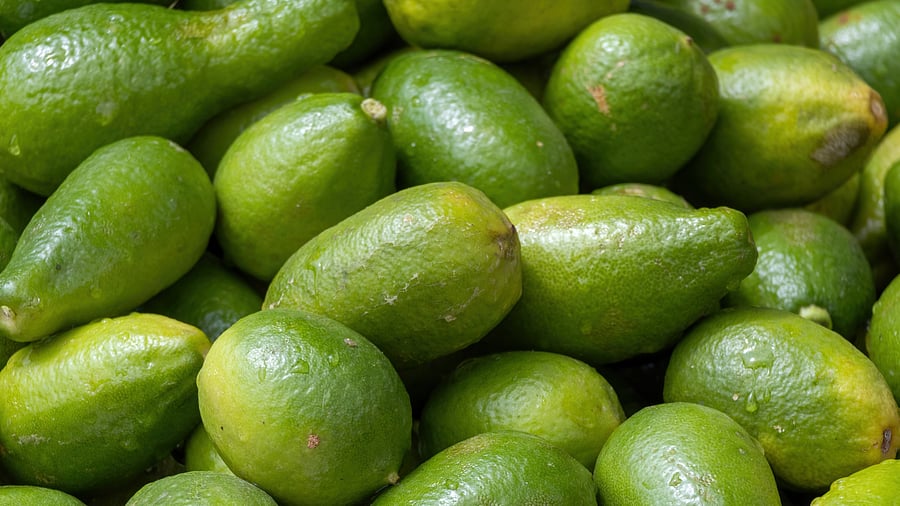
The Gondhoraj is an essential ingredient in the local cuisine of West Bengal and Assam.
Credit: Special Arrangement
Every lemon carries in its scent the story of its journey from shores near and far. This is also true of lemon varieties, infused with tart juices, grown in India several years ago, like the pale yellow elliptical-shaped Nemu Tenga or the Lisbon lemon.
The Nemu Tenga originated from northern Myanmar and has been cultivated in Assam; the bright yellow rough-textured lemon, like the Lisbon lemon, was introduced to Goa by the Portuguese in the 16th century. The Jambhiri lemons arrived in Kashmir from Persia through the ancient Silk Road trade network.
But, there was an oblong or oval-shaped lemon, having a thick, rugged green rind and a heady, sweet floral scent, which outclassed the others. This was, indeed, the ‘king of lemons’, the Gondhoraj lebu (lemon), identified by various names, that had a fascinating journey, spanning many regions, in the distant past.
Call a Gondhoraj by any other name...
The Gondhoraj is called by different names in different places. For instance, the aromatic Rangpur lemon too is a type of Gondhoraj lemon. During the British rule, the officers posted in Rangpur division (city in present-day Bangladesh) were so delighted by the sweet, zesty scent of Rangpur lemon in their gin that they carried loads of it on their return journey to England on the seas.
In the north-western regions of Bangladesh like Sylhet, the Gondhoraj was known as the Shatkora lime whose thick, slightly rough-textured green rinds imparted an intense lemony flavour to Sylheti lentil cuisines like the spiced masoor dal or fish curries.
Also, during the time of the British Empire, Assam had another variety of the fragrant Gondhoraj, the Kazi (aka Kaji) Nemu or the Jara Tenga lemon varieties that thrived in the alluvial soil-rich farmlands of Barak Valley region, the homeland of several Sylheti Bengalis. Soon, by way of the historical Brahmaputra river trade route between Assam and Bengal, the Gondhoraj made its way to Burdwan, Hooghly, Midnapore and other Gangetic regions of British era- Bengal. In fact, for the zamindars of the Burdwan Raj, the fragrant Gondhoraj lemon was valued highly because of its uniqueness in transforming cuisines to higher levels.
The popularity of the Gondhoraj lemon, known by distinct names, has not slackened. As a matter of fact, in recent times, the uniqueness of the Gondhoraj has meant a burgeoning cultivation – it is cultivated extensively in regions bordering the vast coastal stretch of Sunderbans located in South 24 Parganas, West Bengal; southern parts of Assam like Cachar and Jharsuguda district in Odisha.
The favourable warm, humid climatic conditions combined with the rich alluvial soils of these regions have helped create the Gondhoraj lemon. Furthermore, the Gondhoraj’s climate-resilience implies a broader acceptance of the lemon in agricultural practices, thereby, providing economic benefits for the harvesters.
Quintessentially Bengali
For a Bengali like me, the unique fragrance of the Gondhoraj lebu is special. The lemon has occupied a supreme place in our cuisines for hundreds of years. Curious about the distinct fragrance of the Gondhoraj, I flicked through a mixed bag of scientific texts and learnt that the release of essential aromatic oils like limonene and citral, on squashing or finely grating the lemon rinds, bring about that alluring citrusy, floral scent which enhances the flavour of innumerable Bengali dishes.
Take, for instance, the Gondhoraj ghol, the traditional refreshing Burdwan Raj-inspired lemonade, which I had at a traditional Bengali restaurant located in Ballygunge, Kolkata.
A sous chef, who supervised the food preparations during the live buffet held at the restaurant recently, made sure that the Gondhoraj lemon juice was stirred into the spiced ghol (a lassi-like mixture of yoghurt, water, black salt and sugar). He then followed it up by whisking the mixture to a smooth, frothy consistency.
When I decided to whip up Gondhoraj murgir jhol, a Burdwan Raj-inspired dish of a creamy chicken gravy, the scent of the lebu filled the air, as I drizzled its juice and leaves over the chicken before marinating it. The marinade again included finely grated Gondhoraj, along with yoghurt, cashews, and spices. Later, I made a creamy chicken jhol (gravy).
It’s not just Bengal — there is a strong penchant for the highly aromatic Gondhoraj lemon even in other cultures too. The split red lentils-based dish of Assam such as aam ada diya dali (spiced masoor dal cuisine cooked with aam ada/amada or mango ginger), uses the juice and leaves of the Kazi Nemu or Gondhoraj during the final cooking process.
Later, the dish is simmered briefly so as to bring out the delicate floral aroma and flavour of the lemon.
Elsewhere, at some of London’s elite cocktail bars, the aromatic Gondhoraj is being used for enhancing the flavour profile of gin cocktails.
Apart from enhancing the flavour profile of a variety of cuisines, the Gondhoraj lemon has been preferred for its health benefits.
During the British Raj, in 17th-century Bengal, the British officers and soldiers posted there considered the Vitamin C-rich Gondhoraj as an essential lemon variety for fighting ailments like scurvy. Even today, the Gondhoraj is recommended for preventing scurvy.
Additionally, the Gondhoraj is loaded with essential antioxidants which boost the immunity levels, flavonoids that have anti-inflammatory properties and limonoids which are known to have anti-cancer characteristics.
The significant level of citric acid in the Gondhoraj has been known to aid digestion. No wonder then that this lemon variety travels far and wide.